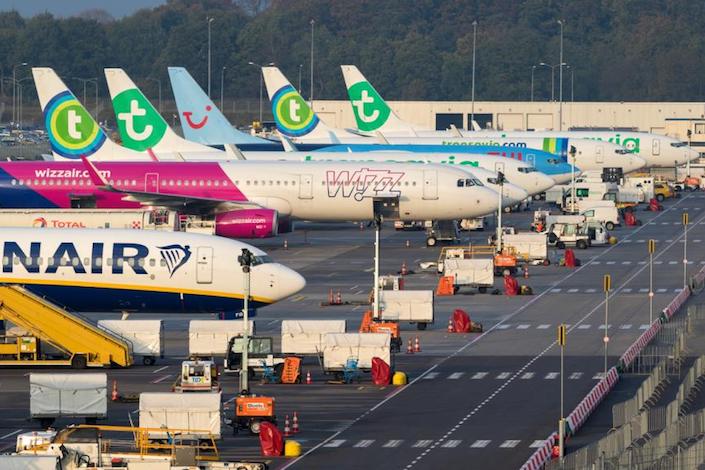Where travel agents earn, learn and save!
News / European aviation: recovery stalls as LCCs trim capacity
Europe has 24.1 million seats vs 36.5 million in 2019 – down 34%

Europe's capacity recovery has stalled in the week commencing September 6, 2021.
Total seat numbers are 34.1% below 2019 levels, which is 0.9ppts worse than last week (week commencing August 30, 2021). The slide is not vast, but it is a change of direction after four months of improving data and then five weeks on a plateau.
Moreover, Europe has slipped into fourth place in the regional capacity recovery ranking. The Middle East, where seat capacity is down by 43.1% versus 2019, remains at the bottom. Asia Pacific is down by 40.8%, Africa by 32.6%, Latin America by 25.6%, and North America by 20.5% this week.
The small slide in Europe's capacity trend as a percentage of 2019 is only one week's data. However, it reflects both a slide in the trend of intra-Europe capacity, which has led the recovery in recent months, and in the trend of LCC capacity versus 2019 levels.
Europe's low cost airlines have consistently been more responsive to market fluctuations during the coronavirus pandemic, growing more in upturns and cutting more in downturns. LCC capacity movements are worth noting.
Europe has 24.1 million seats vs 36.5 million in 2019 – down 34%
In the week commencing September 6, 2021, total European seat capacity is scheduled to be 24.1 million, according to OAG schedules and CAPA seat configurations.
This is 34.1% below the 36.5 million seats of the equivalent week of 2019. This is also 0.9ppts worse than last week's 33.2%, the first downward movement in this metric since April 2021 (not counting a slide of 0.2ppts two weeks ago).
This week's total seat capacity for Europe is split between 7.3 million domestic seats, versus 8.4 million in the equivalent week of 2019; and 16.8 million international seats, versus 28.2 million in 2019.
Europe's domestic seats are down by 13.2% versus 2019, which is a slide down from last week's -10.8% (and further below the high point of -6.3% four weeks ago).
International seat capacity is down by 40.3% versus 2019, compared with last week's -39.8% (the first downward movement for international seats since April 2021).
Europe: percentage change in weekly airline seat capacity vs equivalent week of 2019, weeks commencing August 30, 2019 to September 6, 2021

Europe slips to fourth among world regions by capacity as percentage of 2019
After six weeks when Europe was in third place in the ranking of regions measured by seats as a percentage of 2019 levels, it has slipped down to fourth place, just behind Africa.
The Middle East is the worst performing region, with capacity down by 43.1% versus 2019 this week.
Asia Pacific's seat count is down by 40.8%, Africa's by 32.6% (just ahead of Europe), Latin America's by 25.6%, and North America's by 20.5%.
Asia Pacific and Africa have taken upward steps in the trend this week, whereas North America and Europe have moved downwards and Latin America and the Middle East are broadly flat on last week.
Percentage change in passenger seat capacity vs 2019 by region, week of March 30, 2020 to week of September 6, 2021

Europe: 3Q2021 seats projected at 64% of 2019 levels, 4Q2021 at 81%
According to data from OAG and CAPA, seat numbers for September 2021 have been trimmed by 0.5% since last week and are projected to be 66% of 2019 levels.
Capacity for 3Q2021 is planned to be 64% of 2019 levels, broadly the same as last week. This compares with 27% in 1Q2021 and 34% in 2Q2021.
Schedules filed for 4Q2021 project capacity at 81% of 2019 levels – down from 82% planned a week ago, but a further step up from 3Q2021.
Annual 2021 seat capacity for Europe is projected to be 53% of 2019 levels, only 11ppts better than the outturn of 42% of 2019 seats for 2020.
Intra-Europe has consistently outperformed total Europe capacity
The capacity recovery in Europe has been led by intra-Europe capacity.
In the week of September 6, 2021, while total Europe seat count is at 65.9% of 2019 levels, intra-Europe capacity has reached 71.9%.
As with total capacity, intra-Europe capacity as a percentage of 2019 has slipped off its recent peak (down 1.4ppts from last week).
Nevertheless, is has consistently outperformed total Europe capacity, particularly when the capacity recovery has been most positive.
Intra-Europe and All Europe: weekly airline seat capacity as a percentage of the equivalent week of 2019, December 30, 2019 to September 6, 2021

LCCs have grown more in upturns and cut more in downturns
LCCs are leading the intra-Europe recovery, but they have underperformed when the recovery has slowed or stalled.
In the week of September 6, 2021, LCCs' intra-Europe capacity is at 76.9% of 2019's, versus all intra-Europe at 71.9%. The LCC trend is 2.0ppts below last week, when it reached a peak of 78.9% of 2019 capacity.
However, in 1Q2021 LCCs' intra-Europe seats fell to around 15%, while all intra-Europe was around 25%.
The LCC annual share of intra-Europe seats share increased from 41.5% in 2019 to 42.4% in 2020.
However, because LCCs cut capacity much more rapidly than other operators during 1Q2021, their annual share of intra-Europe capacity is projected to fall to 40.3% in 2021 (based on current schedules from OAG and seat configurations from CAPA).
In the current summer period Europe's LCCs – particularly the ultra LCCs (see below) – are taking greater advantage of the partial recovery. Their seat share is projected to be 43.8% in 3Q2021, compared with 41.6% in 3Q2019.
Intra-Europe: weekly airline seat capacity as a percentage of the equivalent week of 2019 for LCCs and for all airlines, December 30, 2019 to September 6, 2021

Ultra LCCs: Wizz Air is at 96%, Pegasus at 94%, and Ryanair at 92% of 2019 seat capacity
The ultra LCC Wizz Air Group has only 30% of the seats of Ryanair Group, but is at 96.4% of 2019 capacity in the week of September 6, 2021 (source: CAPA/OAG). It is projected to reach well over 100% at the start of the winter season (126% in the week of October 25, 2021 and over 160% in the following week).
The Turkish ultra LCC Pegasus Airlines, one fifth the size of Ryanair by seats, is at 94% and projected to exceed 100% in November 2021.
Ryanair – Europe's leading LCC, and leading airline group of any business model by seat capacity – is currently at 91.7% of its 2019 seats. Current schedules project that the ultra LCC will be back over 100% of 2019 levels at the start of the winter season in late October 2021.
EasyJet is at 61%
Not all of Europe's LCCs have returned capacity as quickly as Ryanair, Pegasus and Wizz Air.
EasyJet Group, Europe's number two LCC, is at 61% of 2019 seat numbers, below the overall European average of 66%. It is projected to reach 82% by the end of 2021.
LCC subsidiaries: Transavia is at 94%, Vueling at 80% and Eurowings at 52%
Among the low cost subsidiaries of the leading European legacy groups, Air France-KLM's Transavia is recovering most rapidly, while Lufthansa's Eurowings is the slowest.
Transavia is at 94% (the Dutch arm at 89% and Transavia France at 99%). It is projected to exceed 100% in mid October 2021, led by Transavia France. At the end of 2021 it is projected at 129% of 2019 capacity (Transavia France at 168%, with the Dutch arm at 93%).
IAG's Vueling is at 80% of 2019 capacity and projected to reach 100% by the end of 2021. Eurowings is at 52% and projected to exceed 100% in late December 2021, before easing back to around 90% in the early weeks of 2022.
LCC capacity movements are worth noting
LCCs have been more nimble both entering and exiting markets during the pandemic, building on their much more flexible culture developed over many years before the COVID-19 crisis. Their response to changing market conditions should not be ignored.
According to data from CAPA/OAG, all of the leading LCCs have a lower percentage of 2019 seat numbers this week compared with last week (apart from Ryanair, which is flat).
The small decline in total European capacity as a percentage of 2019 seats may prove to be just a blip in what is a fairly volatile data series.
Nevertheless, the accompanying slide in LCCs' intra-Europe seats as a percentage of 2019 levels is a cause for at least some concern.








